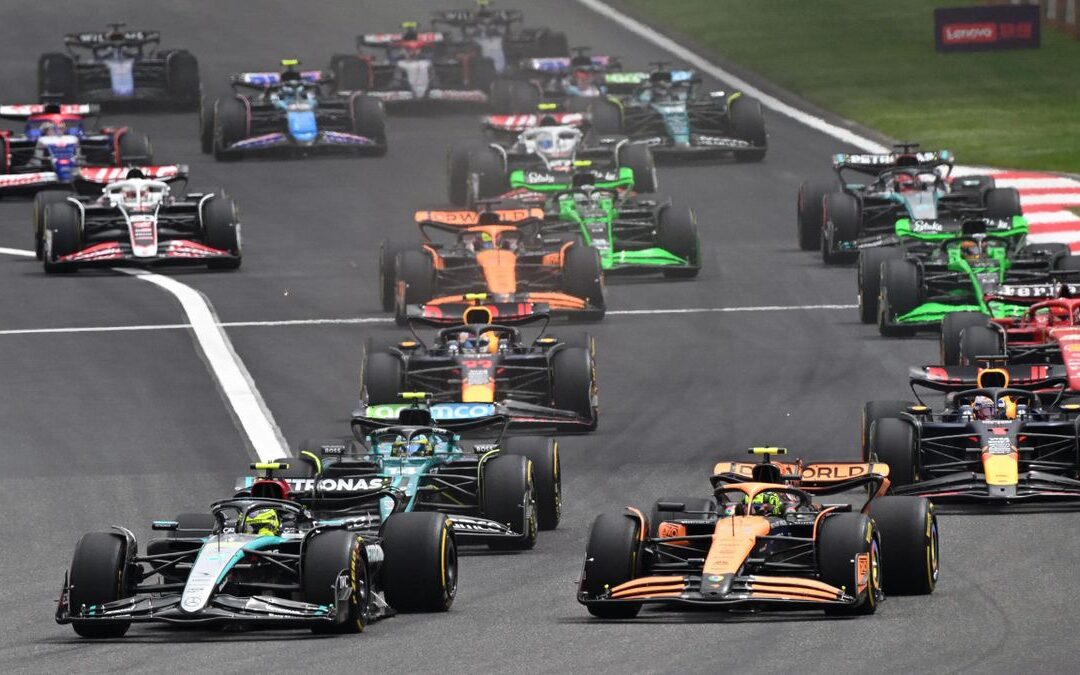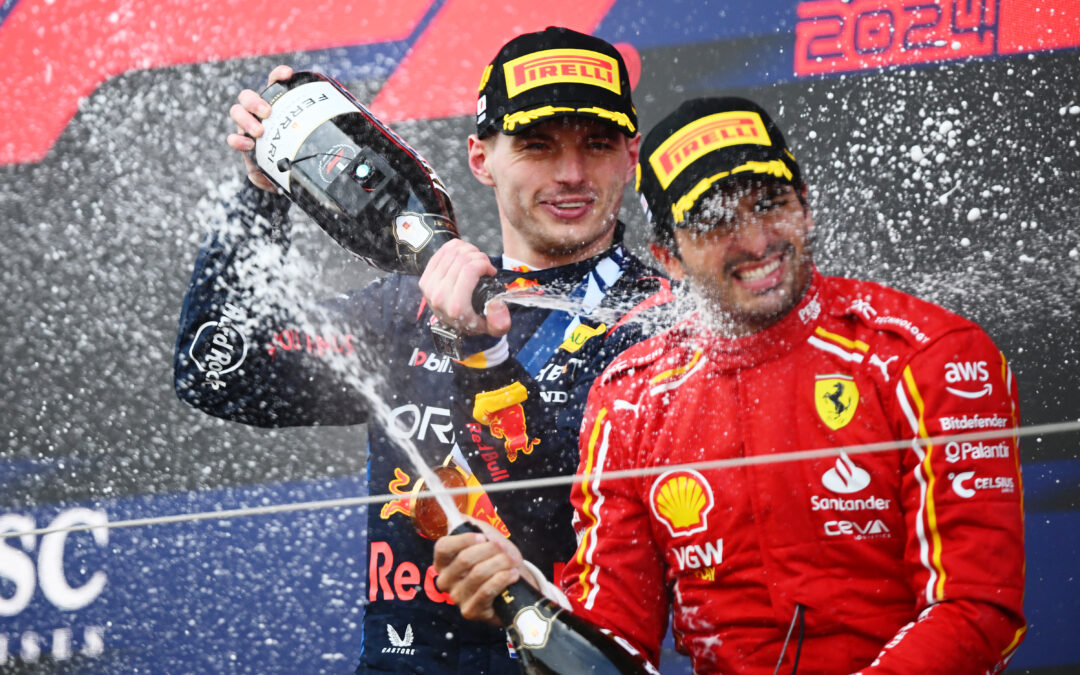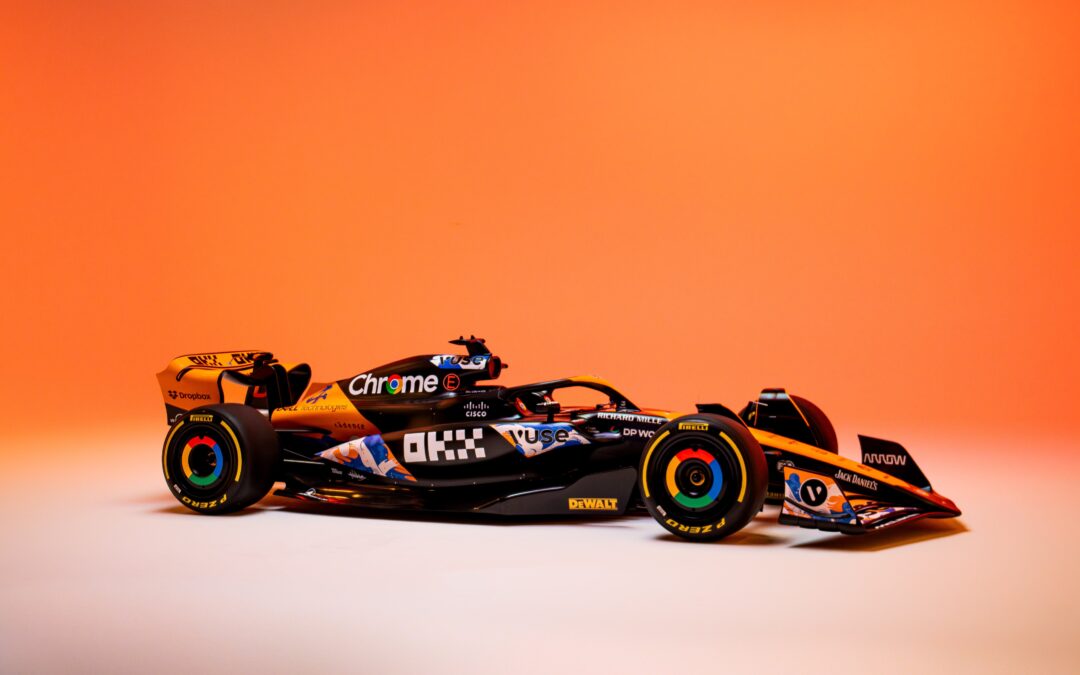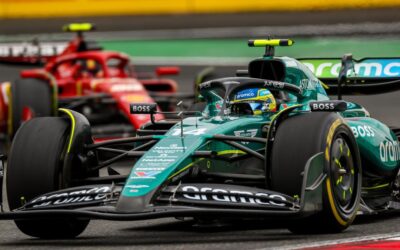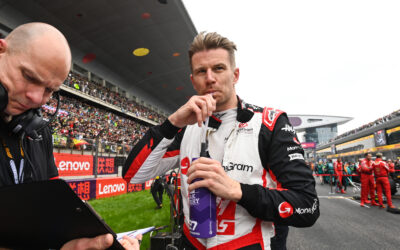The Curious Case of Charles Leclerc
The lights in Yas Marina had not gone out yet when the first titles started popping up all over Social Media: the second-best controversy of the evening – one accompanied by a self-serving feeling of satisfaction, like some sort of weird, twisted revenge – erupted into a narrative that this article will try to disprove.
Just as Mercedes was moving war to Michael Masi, journalists and media personalities (mostly on the Italian Side Of Things) were telling us that Charles Leclerc was no longer. That Carlos Sainz was now the rightful “Number One”. That Ferrari’s “Golden Boy” was never really worth the hype and that had finally been proven. Etcetera, etcetera.
Without even trying to argue against the “opinion” behind the (rather premature) Career-Death Sentences, the first impression one has after following – or trying to follow – the conversation is that not many seem to have been paying attention to Charles Leclerc this year. He said it himself, after the Italian Grand Prix: “I feel like every time I do a good race, I’m never on TV because there’s always something else going on”. He said it again after the Turkish Grand Prix, and after the race in Austin: “it must look boring from the outside, but I feel like I was very good today”. Finally, after Jeddah – and having his race ruined by the first Red Flag – he said: “no one will be looking at my pace, only the result”.
Ferrari’s Team Principal Mattia Binotto spoke his first comments on the season on Leclerc’s Team Radio before they could even get him in front of a microphone. “You have been very unlucky this season,” he told his star driver. Our boy Chuck joked about his bad luck a while ago, too: “maybe I should go to Lourdes, I don’t know what else I can do”.
On top of the bad luck (we will come back to this point later), Leclerc’s “good season” was completely overshadowed by other events. After all, with such a close title fight – and all the drama around it – there really was not much of an incentive to look at what was happening in the midfield – least of all when Mr “Best of the Rest” does not end up on the podium.
Contrary to what one might think looking at the standings, Charles Leclerc is actually the driver who finished most consistently as the “leader” of the midfield – often with considerable gaps to his rivals. Ten Top 5 finishes this season for him, more than anyone else in the Formula 1.5 championship, six P4 to his name, and only one podium between the chaos and the sheer bad luck.
If one wanted to take a short walk down memory lane –
In Imola, Leclerc spent the entire first (wet) half of the race in the run with Max Verstappen and Lewis Hamilton, and was second in the racing order with a 27 seconds gap to Norris before the Red Flag. He lost his radio at the restart, was caught by surprise by the (botched) procedure and lost position to his rival in the McLaren and a “blessed” Lewis Hamilton.
In Barcelona, Leclerc overtook Bottas at the start with a masterful move on the outside of Turn 3, and kept the much faster Mercedes behind for the entire duration of the first stint. He finished the race just outside of the podium, with a 10 seconds gap to Pérez and nowhere near his ‘mates’ in the midfield.
In Silverstone – in his opinion, “my best race this season” – Leclerc went very, very close to winning the race, and finished on the podium just behind Lewis Hamilton, with an 11 seconds gap to Bottas in P3.
In Monza – a race that was supposed to go all wrong for the Scuderia – Leclerc finished fourth after keeping up the pace with much faster cars, and even engaged in a battle with Bottas to show that he was not willing to give up the position so easily.
In Istanbul, Leclerc was so fast that Ferrari believed he could win the race, and gambled on a strategy that put him out of contention for a podium that was his from the start. He finished in P4, with absolutely no regrets.
In Austin, Leclerc’s Ferrari raced – not for the first time – in a limbo between the Top 2 and everyone else. He was close to catching Pérez for P3 by the end of the race, and finished again just out of reach of a podium – 24 seconds ahead of Daniel Ricciardo’s McLaren.
In Interlagos, he made a strong comeback after a disappointing Qualifying and Sprint Race and finished once again as “best of the rest”.
The thing about Leclerc – he falls down from time to time; he will touch a wall in Monaco, take Pole Position and then he won’t even start the race. But the other thing about Leclerc – he always gets back up on his feet.
At the Styrian Grand Prix, he fell to the back of the grid after making contact with Pierre Gasly on Lap 1. Leclerc pitted, overtook half the field, then stopped again and kept overtaking the cars in front of him – providing the sole source of entertainment in what would have been, otherwise, a rather boring race. Just a week after, on the same track, he was pushed out into the gravel twice by Sergio Pérez; this ruined his tyres, and so Leclerc accepted, without complaints, to swap position on track with his teammate to try and catch Daniel Ricciardo’s McLaren.
And wasn’t Ferrari’s 2021 season all about teamwork? All about working together, as a team, to secure P3 in the Constructors’ Championship ahead of McLaren – personal interests be damned? It was, said Mattia Binotto – and when he is poked again about the presumed rivalry between his drivers, about how ‘Home Hero’ Charles must be feeling, he only says: “the competition will be beneficial to both. I expect Charles to be even more determined next year. I know how he works, he will analyse every bit of data, he will go back to every race and he will learn whatever there is to learn from it. He has been doing it all season – I have seen the way he has improved this year. He will only keep improving.”
 Charles Leclerc on the podium at the British Grand Prix – his only podium of the season. He reminds us of a certain someone, sharing the bottle with his mechanics…
Charles Leclerc on the podium at the British Grand Prix – his only podium of the season. He reminds us of a certain someone, sharing the bottle with his mechanics…
Luck be a Lady – but Misfortune is a Bully
Four big zeroes cost Leclerc a substantial amount of points in the standings. Despite that, in the direct comparison Charles emerges as the King of the Midfield Battle yet again – but also as the driver involved in said battle (the famous “P5 Deathmatch” which no one really took notice of) with less podiums – in fact, just the one – to his name. Which is rather ironic.
One podium was lost in Imola after the Red Flag. One was lost in Turkey because if Charles had stayed ahead of P2 he would have finished the race in P1 (one might wonder – why the hell did Ferrari even risk that much with the strategy? And the answer is: because Leclerc is worth the gamble). Leclerc also had a shot at a Race win in Silverstone – but mostly what everyone will immediately think of when talking about “missed opportunities” is the Monaco Disaster.
It will not be easy for Charles – it might take an entire winter – to get over the Race That Never Was in his hometown: a result that could have been worth 25 points, and the first win for the Scuderia since Singapore 2019. His fault for getting too close to the barriers, of course – although never has it happened in recent years that damage from a crash in Qualifying would cause a DNS. Indeed, the damage on Leclerc’s car was both undetectable and unprecedented – Ferrari had to update their checklist after the failure happened on the Sunday morning as soon as Charles got out of his garage convinced he could start the race. Just his luck.
In Hungary, he was running near the top when he fell victim to a Stroll-attack (Leclerc called it “a nice bowling game”) which denied him the chance to race more than half a lap around the Hungaroring. His teammate, Carlos Sainz, was starting the race from P15 after a shunt in Qualifying: he got a podium in a crazy race where everything happened – from Lewis Hamilton being the only driver lined up on the grid, to half the Top 10 being taken out, to Ocon winning, to Vettel being disqualified.
In Russia, after serving a 20 places grid drop for taking a new Power Unit and overtaking seven cars in two corners at the start, Leclerc was running behind his teammate (who had started the race in P2) when it started to rain. There was no gap to stop both of them in the same lap for a set of Intermediate tyres, and so Ferrari prioritised the driver ahead on track. Half a lap later, the rain got worse and Leclerc fell back and out of the points after an amazing recovery race – while his teammate once again celebrated on the podium.
In Qatar, a broken chassis prevented him from qualifying in the Top 10 (though it should be noted that despite the considerable damage, Leclerc still somehow out-qualified Ricciardo). Another recovery race – one where on top of everything else he needed to manage the pace to make the one-stop strategy work. He later got stuck in P8 behind his teammate with orders not to overtake and to look after his tyres.
In Jeddah, after crashing in FP2, Leclerc does one of his mega-laps in Qualifying and starts the race in P4: he has the pace to keep Pérez behind and maybe even catch up with Bottas, but an early Safety Car triggers a strategic pitstop – which turns into nothing but a loss of track position when the Red Flag is called to replace the Safety Car. At the first restart, Pérez squeezes him into a barrier and Leclerc loses another position. At the second restart, he’s barely ahead of his teammate who was starting yet again in P15 after crashing in Qualifying. He will be overtaken, and then he will overtake Sainz back on the second-to-last lap of the race: fair and square, no team orders involved despite him being on the preferred tyre strategy to catch Gasly and Ricciardo at the front. Once again, the result will not match the potential – nor the expectations – of the driver.
The Abu Dhabi Grand Prix was not Leclerc’s best race – he said it himself, as usual pretty honest when it comes to evaluating his own performance. Yet there is no mathematical doubt that the second stop during the Virtual Safety Car period (a wrong call, in retrospect) lost him not only the P5 he had just gained on Norris in the Drivers Standings, but also P6.
Leclerc says he doesn’t care. Or at least he pretends not to. “It’s just P5, it is what it is – I’d rather have it happening to me now than when I’m fighting for actual results”. Mattia Binotto doubles down on it, and again says: “Charles had a rather unlucky season – the results do not reflect his performance at all”.
There will always be someone pointing out that the Ferrari Team Principal – the Defender Supreme of the “Predestinato” (“the Predestined” – a rather odious, premature nickname) – is only denying the obvious: Leclerc has lost to Sainz, he has been the worse driver this season. But the point is rather that he wasn’t – and whoever has watched this season cannot say that Sainz has out-performed Leclerc. Those who do… well, antipathies are nothing new in sports journalism.
However they often cloud one’s better judgement – and so the most important details are ignored in favour of a narrative: but if the wind in Maranello blows in Leclerc’s direction, there must be a reason why.
And that reason has just won a World Championship.
 Leclerc and Verstappen are childhood enemies. Apparently, they say “hi” to each other now. Since his debut in Formula 1, Max has been addressing Charles as his “biggest rival”.
Leclerc and Verstappen are childhood enemies. Apparently, they say “hi” to each other now. Since his debut in Formula 1, Max has been addressing Charles as his “biggest rival”.
Red Bull gave Max his wings – Ferrari has a Charles Leclerc
Max Verstappen is Champion of the World, like it or not.
Before this season – and even at some points during – there were tons of doubts about Max: still too young, too impulsive, he is not ready to fight Sir Lewis Hamilton, ‘Crashtappen’ will push you out because he is such a terrible driver.
Lost in a sea of angry British pundits and the “confused” Race Direction, the only thing that kept the fight on a boat was what Max was doing on the track. And Max was scoring big points, so Max got the title in the end.
It took him quite some time – seven years in Formula 1 – and he is still rather the aggressive driver; but just like Lewis Hamilton, Max Verstappen is the kind of driver whose highs are so high people are willing to overlook the lows.
Just as it happened for Max – who was recruited by Helmut Marko when he was only 15 years old – Ferrari saw something in a kid named Charles, who had also caught the attention of Herr Doctor. The Scuderia signed him in their Academy the same year Verstappen became a Junior Red Bull driver – but while Max was thrown straight into a Formula 1 car, Ferrari chose a different path for their young talent: he would be going through the junior categories, and would only sit at the “big boys’ table” once he was ready for it.
Leclerc was placed under special surveillance from Ferrari throughout his entire junior career. He won the Formula 3 and Formula 2 titles on his debut season – annihilating the competition. In 2017, the Scuderia rewarded him with another taste of Formula 1 after the first short test at Silverstone in 2016: a session at the Hungaroring, where Leclerc got to drive the SF70H.
What happened – and one must remember, this was only the second time Leclerc got to drive a Formula 1 car – was that he beat Vandoorne’s time by less than a tenth of a second. But while Vandoorne’s personal best was set on the faster Ultrasoft tyres, Leclerc set his time on the Soft compound – two grades harder than the Ultrasoft. Indeed his record lap was only 1,5 seconds off Sebastian Vettel’s Pole lap that same weekend. His lap would have been good enough to grant him P9 on the starting grid of the 2017 Hungarian Grand Prix.
One thing is immediately evident: the kid is fast. He knows how to win, and he is ready. Marchionne insists on him, he wants young Charles in his Scuderia – Binotto, Technical Director at the time, approves of the plan. He has been watching Leclerc very closely.
Leclerc’s debut in Formula 1 – for Sauber-Alfa Romeo – happens in 2018; the young rookie easily beats his more experienced teammate Marcus Ericsson and places a car that had nothing to do with the Top 10 in Q3 and then in the points on several occasions. Already halfway through his debut season, there’s talks of him getting the infamous Red Seat – and yet no one thinks it will really happen: why would Ferrari – the stoic, historic team, the one with the Champions – go for a kid the way Red Bull had done?
But Ferrari is rather looking at Max Verstappen: the wild troublemaker with the very high highs and the messy low lows, who had gained himself the nickname of “Champion in the Making”. And so the Scuderia just goes for it – they sign Leclerc, and they match him with a Top Dog who doesn’t like to share, almost as if they wanted them to throw spanners at each other from the opposite ends of the garage.
In his first season with Ferrari, while he is still pretending to be Vettel’s Number Two, Charles almost wins his second race with the team (he would have won in Bahrain if it weren’t for that issue on his engine) – and then he actually does win, in Spa and then in Monza, back-to-back, and he beats the Four Time World Champion Sebastian Vettel, the “inconvenient” Number One, at the end of the season.
Just a year later, Leclerc is given the keys to the team. He has convinced Ferrari that the time has come to change direction: not with his words, not with dirty politics – but just with his performance on the track. On his side, no longer a Champion, but Carlos Sainz – a driver with seven years of experience in Formula 1.
A rock-solid driver – yet Leclerc remains the wave that threatens to sweep everything away.
 Leclerc, the enfant prodige, wins in Monza – “at home”, where the team hadn’t won since 2010 – in his first year with Ferrari.
Leclerc, the enfant prodige, wins in Monza – “at home”, where the team hadn’t won since 2010 – in his first year with Ferrari.
Leclerc and Sainz Are Not the Same Kind of Driver
Consistency is key. Sainz’s consistency throughout this season has awarded him with a Top 5 finish in the Drivers Standings. “Best of the Rest”, “King of the Midfield”, the Spanish driver put in a stellar performance in his first year with the Scuderia – but this should not be used as a gratuitous insult to throw at his teammate who certainly did not lack consistency this season.
The positives in Leclerc’s season greatly outnumber – and outweigh – the negatives. His highs have been pretty high – and still very much out of reach for his “more consistent” teammate.
And yet the narrative at the end of the season is that Leclerc has fallen back, that he has disappointed, not met the expectations – but if it is true that Carlos Sainz finished ahead of Ferrari’s “Golden Boy” in the standings (with a gap of 5,5 points), it is also true that the Spaniard has lost every direct comparison with his teammate: 14-8 in Qualifying (before penalties, counting Sprint Qualifying as the official Qualifying result) and 14-6 in race finishes.
Aside from the thousands of clickbaity articles that write themselves after taking one glance at the final standings and reaching a conclusion that doesn’t really tell the whole story, the real takeaway of Ferrari’s 2021 season is that the Scuderia might have the best driver pairing on the grid: on one side, quick-footed Charles Leclerc, on the other the cautious consistency of Carlos Sainz – they make a united front in every battle the Scuderia will get involved with in the future.
There is always a “but” in this comparison, of course – there are a lot of “buts”, and like chickens they come home to roost the moment Ferrari says that Leclerc is the driver who will win them a title in the future and everyone acts surprised, or like that is a dig at poor Carlos Sainz. It is not, though, when you look – when you really look – at Leclerc’s career. At his achievements, at the way he drives – like all he cares about is winning.
Sainz has nothing to learn from him – because what Leclerc does cannot be taught; on the contrary, Charles has everything to learn from Carlos’s experience. All the time, he keeps improving, season after season, steadily growing into the young champion Ferrari wants for themselves.
After all, Ferrari doesn’t just hand out a five-years contract to the first guy who walks past the gates of Maranello. They will give it to the kid – like a vote of confidence – who has been setting records since he was only 15.
They will give it to their Little Champion In The Making – and then make him one.
Author: Sara Esposito



